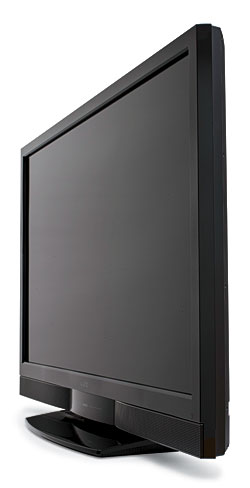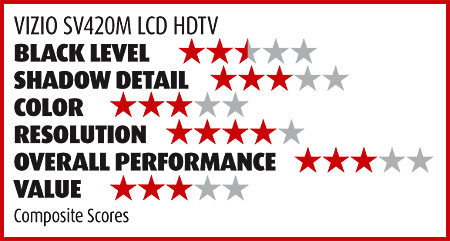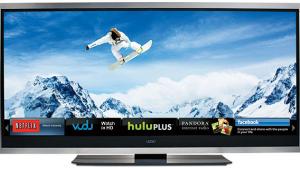Vizio SV420M LCD HDTV Page 2
 While the Vizio has no gamma adjustments, the gamma in its Movie mode was just over 2.3. Expert recommendations for playback gamma (which characterizes how a set’s brightness level varies with changes in the input level) range from 2.2 to 2.5.
While the Vizio has no gamma adjustments, the gamma in its Movie mode was just over 2.3. Expert recommendations for playback gamma (which characterizes how a set’s brightness level varies with changes in the input level) range from 2.2 to 2.5.
When the Vizio plays back a 4:3 source in the 4:3 (Normal) aspect ratio setting or a letterboxed source that needs to be played in a zoom setting to fill the full width of the screen, the set can only produce a geometrically correct image when the input is 480i or 480p. When 720p, 1080i, and 1080p inputs are externally upconverted to these resolutions from standard-definition sources, they are squeezed or stretched, and no aspect ratio choice can put them right. (This is not a problem with sources that require a Full setting, such as native HD material and enhanced-for-widescreen DVDs.)
The Vizio has one other unique feature: It’s the only set in the group that offers a picture-in-picture (PiP) option. But this is only available through the set’s onboard tuners or A/V (composite or S-video) inputs, which limits its usability.
The Nitty Gritty
The Vizio landed in fourth place overall for black level and shadow detail combined, just marginally behind the LG and in front of the Toshiba. True, the Vizio did tie with the LG for second place in shadow detail. But first place was also a tie, and the spread of the scores between the first tied group of two and the second-place pair was a chasm.
“Not good,” was one panelist’s succinct summary for both of these categories. Another found the Vizio’s shadow detail to be the least impressive of the group on the Seven Years in Tibet clip. A third rated the black level as “disturbingly high,” but she rated the set’s shadow detail in the middle of the pack and called it “pretty good.” However, she did remark that the set lost some shadow detail when part of the image was very bright. The effect of this on other aspects of a set’s performance was emphasized by a panelist who commented that objects didn’t look as dimensional and lifelike as they did on some of the other sets.
Three of the panelists saw deterioration in the set’s image quality when they moved off axis. But on the positive side, others noted that the set looked much better overall with the room lights on.
 The Vizio’s color was controversial and brought out the most disagreement on the panel. One of those who rated its color tops praised its punchy yellows and reds (although possibly a bit too red with fleshtones) on Seven Years in Tibet. She also liked its “sharp, bright picture,” with “natural, bright blues on Fly Away Home” and “really vivid colors on Casanova. Eye-popping—this is exactly the kind of movie I would watch with this one.” The other judge who rated the Vizio high for color also praised the saturated hues on Casanova and The Dark Knight, as well as the set’s beautiful green, reds, and browns in Fly Away Home.
The Vizio’s color was controversial and brought out the most disagreement on the panel. One of those who rated its color tops praised its punchy yellows and reds (although possibly a bit too red with fleshtones) on Seven Years in Tibet. She also liked its “sharp, bright picture,” with “natural, bright blues on Fly Away Home” and “really vivid colors on Casanova. Eye-popping—this is exactly the kind of movie I would watch with this one.” The other judge who rated the Vizio high for color also praised the saturated hues on Casanova and The Dark Knight, as well as the set’s beautiful green, reds, and browns in Fly Away Home.
But the other panelists weren’t so positive. Three of them thought the skintones looked a little unnatural, and one of those commented that the colors were too vibrant. Another rated the Vizio’s reds as the worst of the group and the greens as the second worst. While the set finished last in the composite scores for color, two of the panelists rated it highly, giving it a 9 out of 10, while others were much less enthusiastic. This shows just how personal the reaction to color can be. Even with careful calibrations, there can be underlying differences in sets that the available controls can’t completely dial out.
But a second-place finish in resolution did earn the Vizio some bragging rights. One panelist thought Seven Years in Tibet looked juddery and the detail too sharp, with some artifacts. He also thought the set had difficulty holding detail with motion. But he still gave it a respectable score. One of those who gave the Vizio’s color a high rating commented that the color made details pop, especially compared with the Sony’s paler colors—a clear reflection of how difficult it can sometimes be to isolate the various aspects of a video display’s performance. Another panelist commented on the clear textures on the temple walls in Seven Years in Tibet, along with its clarity in showing Brad Pitt’s scars and wrinkles!
Conclusions
While the Vizio didn’t turn in a great performance overall, remember that it is less than 75 percent of the cost of the next least expensive set in the group. I found it much more watchable than the group’s scores might suggest, and its HD video processing also handily beat out the other players in the group.
You can do better if you’re willing to spend more, but this is a respectable set at an attractive price. And Vizio is on the cusp of interesting new models, some of which may well compete more aggressively with the other sets here in the $1,300-to-$1,500 range. It’s also about to join the parade of new local-dimming, LED-backlit sets, which should answer the black level and shadow detail issues, but at a price that might keep other manufacturers awake at night.





























































